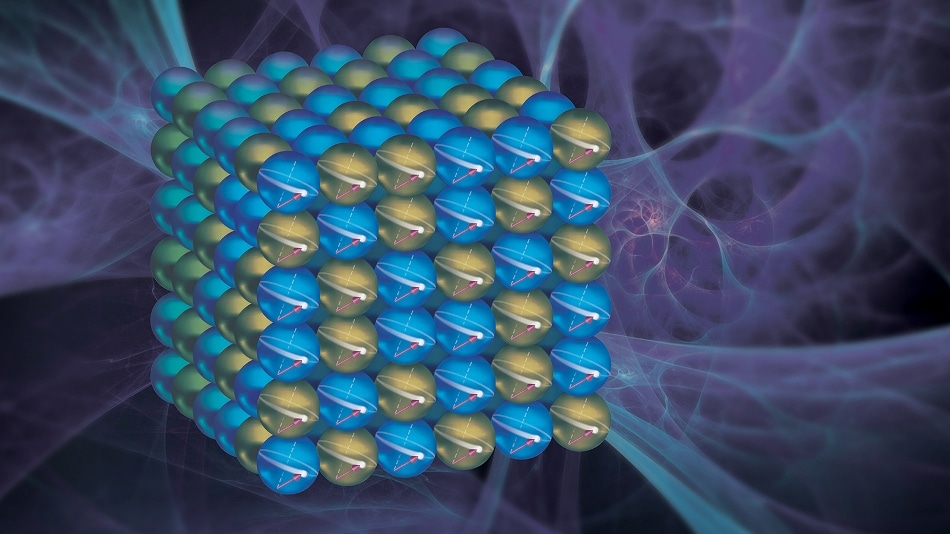Apr 26 2019
At times, scientific discoveries can be made by taking oft-traveled paths. This was exactly the case with a cobalt-iron alloy material usually used in hard disk drives.
 Researchers at Argonne have discovered a way to control the direction of electron spin in a cobalt-iron alloy, influencing its magnetic properties. The result could have implications for more powerful and energy-efficient materials for information storage. (Image credit: Argonne National Laboratory)
Researchers at Argonne have discovered a way to control the direction of electron spin in a cobalt-iron alloy, influencing its magnetic properties. The result could have implications for more powerful and energy-efficient materials for information storage. (Image credit: Argonne National Laboratory)
Scientists from the U.S. Department of Energy’s (DOE) Argonne National Laboratory, together with Oakland University in Michigan and Fudan University in China, have discovered a striking quantum effect in this alloy. The study outcomes have been published in the latest issue of Physical Review Letters.
The effect involves the potential to regulate the electron spin direction, and it could enable researchers to develop more robust and energy-efficient materials for the storage of information. The researchers could modify the magnetic state of a material by altering the direction of electron spin in the material. Optimized control of magnetization such as this enables more information to be stored in and recovered from a smaller space. Optimized control could also enable additional applications like more energy-efficient generators, electric motors, and magnetic bearings.
The effect observed by the researchers was caused by “damping,” where the electron spin direction regulates the way in which the material dissipates energy.
When you drive your car down a flat highway with no wind, the dissipating energy from drag is the same regardless of the direction you travel. With the effect we discovered, it’s like your car experiences more drag if you’re traveling north-south than if you’re traveling east-west.
Olle Heinonen, Materials Scientist, Argonne National Laboratory.
Heinonen is one of the authors of the study.
In technical terms, we discovered a sizable effect from magnetic damping in nanoscale layers of cobalt-iron alloy coated on one side of a magnesium oxide substrate. By controlling the electron spin, magnetic damping dictates the rate of energy dissipation, controlling aspects of the magnetization.
Axel Hoffmann, Materials Scientist, Argonne National Laboratory.
Hoffmann is another author of the study.
The researchers’ finding was observed to be specifically astonishing since the cobalt-iron alloy had been extensively used in applications like magnetic hard drives for several decades, and its characteristics have been absolutely analyzed. Traditionally, it was considered that this material did not have a direction of choice for electron spin and hence magnetization.
However, previously, researchers “baked” the alloy at high temperature to prepare it for use, resulting in the ordering of the arrangement of the iron and cobalt atoms in a regular lattice, thereby avoiding the directional effect. The researchers noticed the effect by analyzing unbaked cobalt-iron alloys, where iron and cobalt atoms can occupy each other’s locations at random.
The researchers could also offer an explanation for the underlying physics. In general, atoms in a crystal structure are located at perfectly regular intervals in a symmetric arrangement. In specific alloys, the crystal structure exhibits slight differences in the separation between atoms, which can be eliminated by using the baking process; these differences tend to stay in an “unbaked” material.
When such a material is squeezed at the atomic level, there is a further change in the separation of the atoms, leading to different interactions between atomic spins in the crystalline environment. This difference accounts for the fact that the damping effect on magnetization is large in certain directions, and small in others.
As an outcome, very small distortions in the atomic arrangement inside the crystalline structure of cobalt-iron alloy offer immense implications for the damping effect. The researchers performed calculations at the Argonne Leadership Computing Facility, a DOE Office of Science User Facility, thus confirming their experimental observations.
The study titled “Giant anisotropy of Gilbert damping in epitaxial CoFe films” has been published in the online edition of Physical Review Letters on March 21st, 2019. Researchers from Argonne include Yi Li, Shulei Zhang, Hyeondeok Shin, Hilal Saglam, Vedat Karakas, Ozhan Ozatay, John Pearson, Olle Heinonen, Axel Hoffmann, and Wei Zhang. Yi Li and Wei Zhang are also affiliated with Oakland University. Fanlong Zeng and Yizheng Wu from Fudan University are other contributors to the study.
The study at Argonne was supported by DOE’s Office of Science, as well as the DOE Visiting Faculty Program.